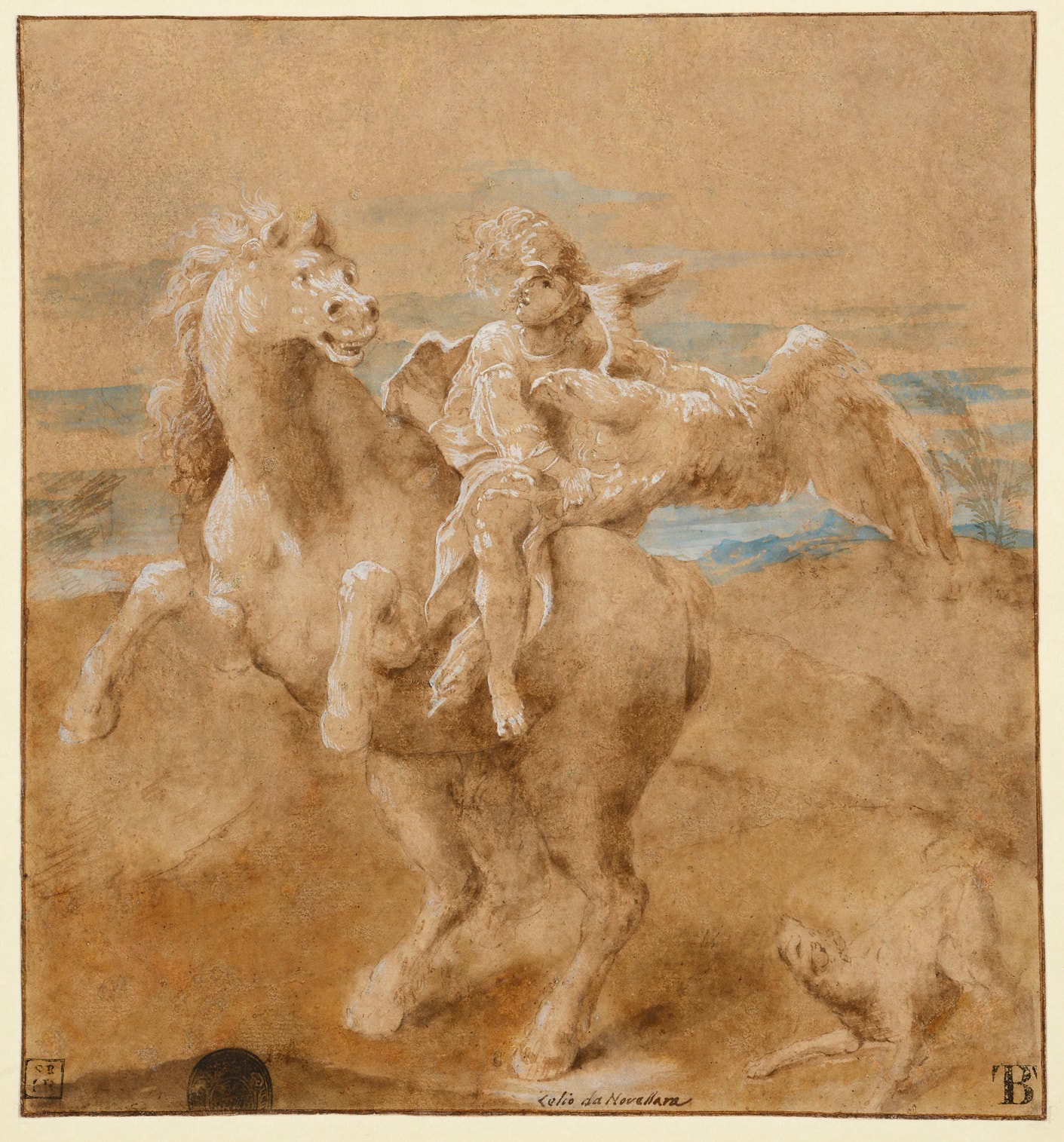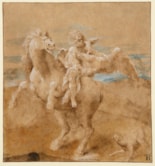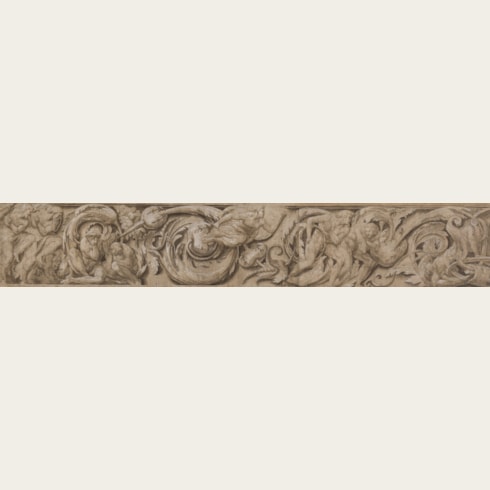Lelio ORSI
(Novellara 1511 - Novellara 1587)
The Rape of Ganymede
Sold
Pen and brown ink and brown wash, heightened with white, with touches of gouache on buff paper, with framing lines in brown ink, on light brown paper.
Inscribed Lelio da Novellara at the bottom centre.
249 x 233 mm. (9 3/4 x 9 1/8 in.)
Inscribed Lelio da Novellara at the bottom centre.
249 x 233 mm. (9 3/4 x 9 1/8 in.)
This highly finished drawing is a splendid example of Lelio Orsi’s fine technique as a draughtsman, typical both in the manner in which the highlights are applied and the distinctive facial types. The drawing is probably a study for a lost fresco which once decorated the facade of a house in Novellara that belonged to the Gentili family in the 17th century, and which was destroyed towards the end of the 18th century. The fresco was described in anonymous account of Lelio Orsi’s paintings in Novellara, written around the middle of the 17th century, as depicting Ganymede on a horse; an unusual and quite innovative treatment of the subject: ‘Above another house of the Gentili family, he painted a Ganymede on horseback, that is still preserved there, and is esteemed by all those who see it.’ The 19th century Novellara historian Vincenzo Davolio also mentions the lost fresco: ‘and we have seen, destroyed not many years ago, the last remnants of some shields depicting naval battles, the war of the Giants, a Ganymede on horseback, painted by Lelio on the facade of the old Gentili house.’
A number of drawings by Orsi of the subject of Ganymede are recorded in old inventories, and these may relate either to the lost Gentili facade fresco, which showed Ganymede on a horse, or to the octagonal ceiling fresco of the Rape of Ganymede by Orsi, formerly in a room of the Rocca di Novellara and now in the Galleria Estense in Modena, in which the subject is treated more conventionally.
The present sheet is first recorded - valued at 2 zecchini - in a 1770 inventory of drawings for sale from the Casino di Sotto, part of the Villa di San Michele, near Novellara; the property of Maria Teresa Cybo-Malaspina (1725-1790), Duchess of Massa, Princess of Carrara and Crown Princess of Modena. In his biography of Lelio Orsi, published in 1892, the 19th century scholar Celestino Malagoli notes what must be the present sheet among the numerous drawings by the artist formerly in the Gonzaga collections in Novellara: ‘In the Gallery of the Gonzaga Princes there were...One hundred drawings in one hundred sheets of carta reale, partly in watercolour, partly in black chalk, and partly in pen, ornamented with carved and gilded frames, and partly in [frames of] ebony with crystal...One can admire in these drawings...Ganymede on a horse abducted by the eagle, in watercolour...’
A very similar rearing horse is found in a large pen and ink drawing by Orsi of The Conversion of Saint Paul in the Ashmolean Museum in Oxford, which was inspired by Michelangelo’s fresco of the subject in the Cappella Paolina in the Vatican. Other, similarly sturdy horses are found throughout Orsi’s oeuvre, such as in a painting of Saint George and the Dragon in the Pinacoteca Nazonale di Capodimonte in Naples.
A very free copy of the present sheet by the English artist William Lock (1767-1847), drawn in pen and brown ink and dated 1808, was recently sold at auction in London.
A number of drawings by Orsi of the subject of Ganymede are recorded in old inventories, and these may relate either to the lost Gentili facade fresco, which showed Ganymede on a horse, or to the octagonal ceiling fresco of the Rape of Ganymede by Orsi, formerly in a room of the Rocca di Novellara and now in the Galleria Estense in Modena, in which the subject is treated more conventionally.
The present sheet is first recorded - valued at 2 zecchini - in a 1770 inventory of drawings for sale from the Casino di Sotto, part of the Villa di San Michele, near Novellara; the property of Maria Teresa Cybo-Malaspina (1725-1790), Duchess of Massa, Princess of Carrara and Crown Princess of Modena. In his biography of Lelio Orsi, published in 1892, the 19th century scholar Celestino Malagoli notes what must be the present sheet among the numerous drawings by the artist formerly in the Gonzaga collections in Novellara: ‘In the Gallery of the Gonzaga Princes there were...One hundred drawings in one hundred sheets of carta reale, partly in watercolour, partly in black chalk, and partly in pen, ornamented with carved and gilded frames, and partly in [frames of] ebony with crystal...One can admire in these drawings...Ganymede on a horse abducted by the eagle, in watercolour...’
A very similar rearing horse is found in a large pen and ink drawing by Orsi of The Conversion of Saint Paul in the Ashmolean Museum in Oxford, which was inspired by Michelangelo’s fresco of the subject in the Cappella Paolina in the Vatican. Other, similarly sturdy horses are found throughout Orsi’s oeuvre, such as in a painting of Saint George and the Dragon in the Pinacoteca Nazonale di Capodimonte in Naples.
A very free copy of the present sheet by the English artist William Lock (1767-1847), drawn in pen and brown ink and dated 1808, was recently sold at auction in London.
‘Lelio Urso in architectura magno, in pictura majori, et in Delineamentis optimo’, reads the epitaph on the tomb of Lelio Orsi, a provincial painter of considerable talent about whom relatively little is known today. He is not mentioned by Vasari or by any other early sources, and most of his paintings are now lost, save for a few easel pictures and some fresco fragments. The son of a minor painter, Orsi is first recorded in 1536 in Reggio Emilia, where he worked on the design of a triumphal arch to celebrate the entry of Ercole d’Este into the city. He continued to work extensively in Reggio Emilia, decorating the façade of the Torre dell’Orologio there in 1544. By 1546 Orsi was working for the Gonzaga of Novellara, a minor branch of the Mantuan family, who remained his most important patrons throughout his career.
While he may have made a first visit to Rome some time in the late 1540’s, he was definitively in the city from 1554 to 1555, and it was here that the influence of Michelangelo was added to the dominant early influence of Correggio, effecting a profound change in Orsi’s style. Throughout the 1560’s he continued to work for the Gonzaga of Novellara, decorating their villa at Bagnolo and providing frescoes for the villas of the Casino di Sotto and the Casino di Sopra, as well as the Rocca di Novellara; unfortunately very little survives of any of these large-scale decorative projects. In 1563 Alfonso Gonzaga decreed that all the houses in Novellara should be decorated with facade frescoes, and Orsi was given the responsibility of designing and executing several of these, including for his own home. A number of drawings by Orsi for such facade and wall decorations are known, although for the most part the frescoes themselves do not.
As only fragments of his mural paintings survive, Orsi’s style as a painter is best seen in a small number of cabinet pictures of mythological and religious subjects that he produced; works which show the continued influence of Michelangelo, Correggio and the studio of Raphael. Little is known of Orsi’s activity in the last fifteen years of his career, which are thought to have been spent working in Reggio Emilia before his death in Novellara at the age of seventy-six.
Lelio Orsi’s drawings – many of which are designs for wall or façade decorations - have survived in greater number than his paintings, and were highly regarded in his lifetime. Often displaying the particular influence of Michelangelo, Orsi’s drawings are characterized by a refined technique and an imaginative approach to composition. The inventories of the Gonzaga collections at Novellara list several sheets by the artist, and enough contemporary copies of his drawings exist to show that they were widely known and appreciated. In later years the 18th century French collector and connoisseur Pierre-Jean Mariette noted how Orsi’s drawings were popular with collectors, writing that ‘les desseins de ce peintre sont fort recherchés. Il a une assez belle plume, et joint au goût terrible de Michel-Ange les graces aimables du Corrège’. Significant collections of drawings by Lelio Orsi are today to be found in the British Museum, the Louvre, the Uffizi and the Royal Collection at Windsor Castle.
Provenance
An unidentified armorial collector’s mark with an eagle (possibly the Gonzaga emblem) partially stamped in black ink near the lower left corner
Maria Teresa Cybo-Malaspina, Duchess of Massa and Crown Princess of Modena, Villa di San Michele, nr. Novellara, in 1770
Sir Joshua Reynolds, London (Lugt 2364)
By descent to his niece, Mary Palmer, later Marchioness of Thomond
Probably the posthumous Reynolds sales, London, A. C. de Poggi, 26 May 1794 onwards or London, H. Philips, 5-26 March 1798 (part of lot 1604?)
Thomas Blayds, Castle Hill, Englefield Green, Surrey (Lugt 416a)
Possibly Samuel Jones-Loyd, Lord Overstone, Overstone Park, Northamptonshire
His daughter Harriet Loyd, later Baroness Wantage
Robert Loyd-Lindsay, Baron Wantage, and Harriet, Baroness Wantage, Lockinge House, Berkshire, until 1920
By descent to Arthur Thomas Loyd, Lockinge House, Berkshire
His posthumous sale, London, Sotheby’s, 28 November 1945, lot 35 (bt. Gernsheim for £64)
Anonymous sale, London, Christie’s, 10 July 2001, lot 26
Flavia Ormond, London, in 2002
Private collection.
Maria Teresa Cybo-Malaspina, Duchess of Massa and Crown Princess of Modena, Villa di San Michele, nr. Novellara, in 1770
Sir Joshua Reynolds, London (Lugt 2364)
By descent to his niece, Mary Palmer, later Marchioness of Thomond
Probably the posthumous Reynolds sales, London, A. C. de Poggi, 26 May 1794 onwards or London, H. Philips, 5-26 March 1798 (part of lot 1604?)
Thomas Blayds, Castle Hill, Englefield Green, Surrey (Lugt 416a)
Possibly Samuel Jones-Loyd, Lord Overstone, Overstone Park, Northamptonshire
His daughter Harriet Loyd, later Baroness Wantage
Robert Loyd-Lindsay, Baron Wantage, and Harriet, Baroness Wantage, Lockinge House, Berkshire, until 1920
By descent to Arthur Thomas Loyd, Lockinge House, Berkshire
His posthumous sale, London, Sotheby’s, 28 November 1945, lot 35 (bt. Gernsheim for £64)
Anonymous sale, London, Christie’s, 10 July 2001, lot 26
Flavia Ormond, London, in 2002
Private collection.
Literature
Vincenzo Davolio, Memorie storiche della contea di Novellara e dei Gonzaghi che vi dominarono, Milan, 1833, [1987 ed.], Vol.III, p.188; Vincenzo Davolio, Notizie storiche di Lelio Orsi, 1836, MS 1836, Novellara, Museo Gonzaga; Giuseppe Campori, Raccolta di cataloghi ed inventarii inediti di quadri, statue, disegni, bronzi, smalti, medaglie, avorii, ecc. dal secolo XV al secolo XIX, Modena, 1870, p.669 (‘Lelio da Novellara. Ganimede a cavallo rapito dall’ aquila, disegno acquerellato, zecchini 2.’); Celestino Malagoli, Memorie storiche su Lelio Orsi, celebre pittore di Novellara, Guastalla, 1892, pp.21-22; Roberto Salvini and Alberto Mario Chiodi, Mostra di Lelio Orsi: Catalogo, exhibition catalogue, Reggio Emilia, 1950, p.6, under no.5; Massimo Pirondini, ‘Opere perdute o non rintracciate’, in Elio Monducci and Massimo Pirondini, ed., Lelio Orsi, exhibition catalogue, Reggio Emilia, 1987-1988, p.251, no.21 (as location unknown); London, Flavia Ormond Fine Arts Ltd., Master Drawings 1500-1895, exhibition catalogue, 2002, unpaginated, no.2.







